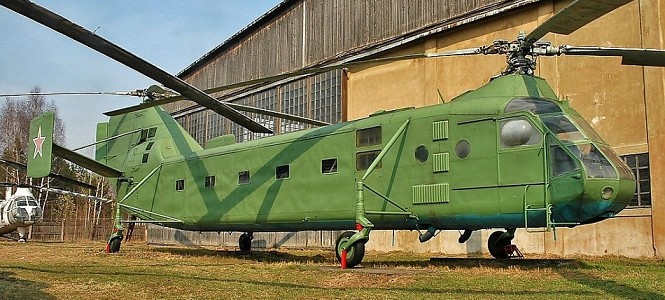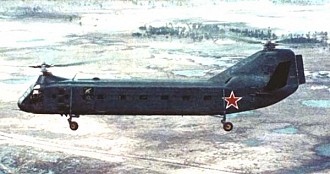Aircraft / Utility helicopters / Yak-24 Horse
Yak-24 Horse
General Facts
- TYPE
Transport helicopter - ORIGIN
 USSR
USSR - NICKNAMES
Horse (NATO reporting name)
Letayushchiy Vagon / flying railroad car (Russian nickname) - DESIGNED
1952 - 1955 - DESIGNER
Yakolev - PRODUCTION
1955 - 1960 - PRODUCERS
 USSR - Yakolev
USSR - Yakolev - QUANTITY
About 100, some reports of only 40 - UNIT COST
Unknown - CHARACTERISTICS
 Large internal volume
Large internal volume
 Good payload capacity
Good payload capacity
 Severe mechanical problems
Severe mechanical problems
Introduction
The Yak-24 is a transport helicopter of Soviet origin. It was produced in the late 1950's to provide more cargo carrying capacity than the Mi-4 Hound. It was the first and last attempt of the Yakolev design bureau to develop a helicopter. Despite breaking various records it was an unsuccesful design. With the introduction of the much more capable Mi-6 the Yak-24 was soon forgotten.
Layout
The design of the Yak-24 is very basic and straighforward. A long box shaped chassis makes up the airframe. The landing gear is fitted to large struts at the front and back. A set of tandem rotors at the front an back provide lift. Two Shvetsov ASh-82V radial engines provide power to the rotors, each engine being able to provide power to both rotors. Despite using the proven rotors and engines of the Mi-4 Hound the Yak-24 proved to mechanically unreliable. The Yak-24 was intended as troop transport and was not armed.
Cargo
The first versions of the Yak-24 could carry 30 troops, 18 strechers or 3 t of cargo. The improved Yak-24U could carry 40 troops or 3.5 t of cargo. The large airframe allowed for 2 GAZ-69A or light anti-tank guns to be carried. The latest Yak-24A was also used as a flying crane and could lift up to 5 t of external cargo.
Avionics
The Yak-24 was a very basic design and did not feature any special avionics or sensors. Operating it at night would have been very hard, if not impossible.
Mobility
The tandem rotor setup made the Yak-24 hard to fly. The powerful engines provide enough power to reach a speed of 195 km/h with a limited amount of cargo. The range is a modest 430 km.
Users
The Yak-24 was only operated by the USSR. Due to the technical problems a small amount was produced and had a short service life. A small amount was produced for civilian use and operated by Aeroflot.
Yak-24 Horse
The Yak-24 was an unsuccesful transport helicopter designed in the USSR in the early 1950's. The Yak-24 was replaced in production with the Yak-24U, which featured an all steel airframe and wider rotorblades. The final Yak-24A was produced in very limited quantities and was capable of carrying much more cargo, both internally as externally.
- Specifications:
- Yak-24U
| Type | Transport helicopter |
|---|---|
| Crew | 4 (2 pilots, flight engineer, radio operator) |
| Lenght | 21.34 m |
| Width | ? |
| Height | 6.50 m |
| Weight | Empty: 11.0 t MTOW: 15.8 t |
| Rotors | Two three blade main rotors of equal size |
| Diameter | Front: 21.0 m Back: 21.0 m |
| Disc area | 693 m2 total |
| Chord | ? |
| Powerplant | 2x Shvetsov Ash-82V radial engine, 1.700 hp each |
| Speed | 175 km/h max |
| Range | 265 km |
|---|---|
| Fuel | ? |
| Climb rate | ? |
| Ceiling | 2.7 km |
| Endurance | ? |
| Landing gear | Four non-retractable single wheels on outriggers |
| Armor | None |
| Cargo | 40 troops 18 stretchers 3.500 kg |
| Avionics | Standard flight controls |
| Self defense | None |
| Remarks | - |
| Weapon systems | - |
| Fixed weapons | - |
|---|---|
| Hardpoints | - |
| Option 1 | - |
| Option 2 | - |
| Option 3 | - |
| Option 4 | - |
| Option 5 | - |
| Option 6 | - |
| Option 7 | - |
| Option 8 | - |


